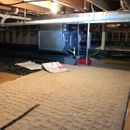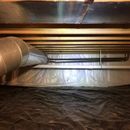ERV installation options?
Hi
I will try to keep this succinct – I purchased a home in SW Montana last year that was built in 2013, climate zone 6. During winter we see temperatures -20F and colder quite often. I’ve been on a journey learning more about construction techniques, building science and now ventilation.
It’s a 2100sqft 3bed/2bath home, standard framed construction over encapsulated crawlspace outfitted with a common ArmstrongAir A95UH furnace and rigid trunk & branch duct system (none of the takeoffs is flex, all rigid duct).
The attic is insulated with blown-in insulation on the ceiling, the roof is vented judging by the vents in the soffits outside.
I’m getting a blower door test performed soon but I imagine it’s constructed reasonably airtight. I’ve been looking at installing an ERV system to improve indoor air quality, as you can imagine, there aren’t many opportunities to open windows. RH stays very low, 18 – 32% – the forced air heating keeps it very low.
First option: the go-to method for all contractors I spoke to so far is to use the existing ducting and connect into the return air. I’m not excited about this method because:
Second option: installing dedicated ducts in the attic. This seems like a non-starter to me to have ducts with heated air go through/on the edge of the thermal envelope as the attic is not conditioned (9F – 25F over the past week).
Third option: second dedicated trunk & branch duct system in the crawl space just for ERV? I have no idea how viable this is? Is there space? Will it be cost prohibitive?
Are there any other ideas? Surely this must come up a lot of retrofits?
Thank you!
Peter
GBA Detail Library
A collection of one thousand construction details organized by climate and house part












Replies
Peter,
The hybrid exhaust ducted setup is a nice alternative for retrofits:
https://www.finehomebuilding.com/2014/11/05/ducting-hrvs-and-ervs
You don't need to interlock with your furnace. Also when your furnace is running it does a good job of tampering the air from the ERV.
The one item you need to check is the pressure in your return duct where the ERV would tie in when your furnace is running. This should be less then 0.1" of water for most ERV blowers.
If you are going to connect an ERV to furnace ducts (where pressure varies significantly and tends to unbalance the ERV), I'd look for a smart fan ERV (eg, perhaps the Intelli-Balance 100).
Hi Peter -
In my neck of the woods (Vermont), the one complaint I hear when our temperatures get in the lower range you see is the amount of time ERV's spend in defrost cycle, and hence lower energy efficiency. But as Joe Lstiburek says, there is no free thermodynamic lunch, in the end.
Peter
There is plenty of room in that crawl space for ductwork, if that's what you decide. If it were my house, I would probably use the hybrid ducted setup that Akos showed above.
FWIW, if your house is running at less than 20% RH, chances are that it is not particularly airtight. Tight houses typically run much higher, especially with no active ventilation. Do that blower door test as soon as you can, and have the tester also look for air leaks at the same time. You might find some big ones that you can easily address.
Finally, I can't tell from your photos if there is any insulation around the perimeter of the crawl space. It looks like the poly is simply hanging down the walls like a curtain, and not particularly well sealed to the poly on the floor. That's not going to do anything useful for you. Well insulated and air-sealed perimeter walls will save you $$, and it's not a hard retrofit, if necessary.
Agreed. Low wintertime humidity indicates higher rates of air leakage. Also, your forced air furnace does NOT reduce your indoor humidity, that's a myth. Dry outdoor air leaking into the house is what keeps your humidity low.
Most forced air systems are not well balanced. So they pressurize or depressurize some closed door rooms. This increases infiltration, which reduces humidity. It's true to some extent.
Ah, I guess when you look at it that way. I was just referring to the "scorched air" comments I see about gas furnaces.
Thank you, everyone, for the great information.
I've been hoping there is a better alternative than the hybrid setups because
a) need to install new exhaust ducting which is still not clear for my original reason (attic no good) - unless I can add additional ducting in the crawl space for this purpose, are exhaust vents at the floor level reasonable?
b) will the relatively low CFM ventilation supply through the return ducts be quieter than the furnace through the supply ducts? the return ducting looks substantially bigger than the supply ducting at least
c) balancing this seems very tricky (to the uninitiated)
but it may be the only viable option.
Great comments about the low RH & crawl space insulation, I'll get that blower door test done asap and take a closer look at the insulation. FYI, there are only 2 people living here, so pretty low occupancy for a 2100 sqft home, which I believe can result in a less humid environment vs high occupancy.
Finally, there was a comment about the "smart fans" - I assume these are fans that dynamically compensate for changes in static pressure or does it mean something else? The Panasonic was actually the first unit I looked at but recently moved it lower on my priority list as the speed doesn't appear variable from a remote control (wall mounted), only on the unit itself. Here's my shortlist that I've gathered so far:
https://docs.google.com/spreadsheets/d/1glBlI3PRnnPE2uSX4-hLMPNHJDbhjt9b9LdHfoXKXfI/edit?usp=sharing
Peter,
I would recommend going with one of the ERVs with a counter flow core (hexagoanl shape), they generally provide much better efficiency for little extra cost. Unless you really need the extra flow of the ERV250, the ERV200/ERV140 is a much better unit.
Since you already have ducts in your crawlspace, there is no reason not to put the ERV there and run the ducts underneath. Most ERVs don't need a drain, this makes installation much easier in such a space.
The ECM blowers are very quiet, the ERV feeding fresh air into your HVAC return duct would be significantly quieter than your furnace blower.
To properly set up and balance the system, you will need a good a good manometer. You can get decent china special one off your usual on-line places. It is a good investment if you ever want to tweak anything down the road.
Generally you don't want to connect the ERV to the supply lines as there is a fair bit of pressure there when your HVAC is running, this would significantly unbalance your ERV.
Usually the pressure in the return ducts is fairly low, to help things, you can install a 90 deg elbow into the return duct pointing into the flow.
Before going down this route, you need to measure the pressure in your return duct. If the pressure there is low (less then 0.1" water), it will not have a great effect on flow balance. For example looking at the ERV200TE operating at 0.4", adding an extra 0.1" pressure loss drops the flow from 222CFM to 205CFM.
Thanks much Akos, good information!
You can compare the tested performance of HVI Certified HRVs and ERVs at the HVI website:
https://www.hvi.org/proddirectory/
Yup thanks, it's on the second tab of my linked spreadsheet :)